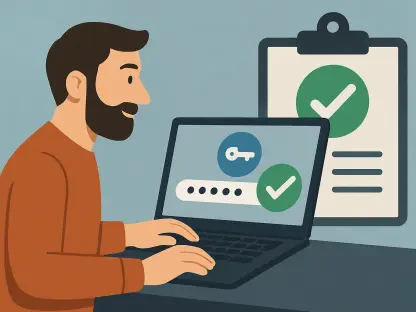For decades, passwords have been the cornerstone of digital security. Valued for their simplicity and ease of use, they have become deeply ingrained in the habits of internet users worldwide. However, these very attributes also contribute to their vulnerability. In an era marked by advanced phishing techniques and persistent data breaches, relying solely on passwords is increasingly seen as inadequate. Emerging technologies like passkeys, biometrics, and Multi-Factor Authentication (MFA) are showing promise in filling the security gaps traditional passwords have left behind, paving the way for a more secure and user-friendly future in digital authentication.
Historical Context of Digital Passwords
The journey of passwords from their inception to their current status highlights their growing critical role in digital security. In the 1960s, the first passwords were introduced with the Compatible Time-Sharing System (CTSS) at MIT, primarily used to restrict access to allocated computer time. This era also saw the first password breach. By the 1970s, researchers began using hashing techniques for secure password storage, recognizing the need for better protective measures.
The widespread use of passwords in the 1980s led to the development of basic password policies, including requirements for minimum length and complexity. As the internet usage exploded in the 1990s, password managers emerged to help users securely store multiple credentials, addressing the growing problem of managing numerous passwords. In the 2000s, early forms of MFA were introduced, enhancing password security with supplementary codes or biometrics. The number of online services surged in the 2010s, leading to password overload, widespread password reuse, and increased data breach vulnerabilities. By the 2020s, cryptographic passkeys began gaining traction, offering more secure and user-friendly alternatives to traditional passwords.
Challenges with Passwords
Despite their longstanding use, passwords present several notable limitations. These challenges stem from both user behavior and the intrinsic weaknesses of password-based security systems. Many users opt for simple, easily guessable passwords, such as “123456,” which makes them highly susceptible to brute-force attacks. Complex password rules often lead to password reuse across multiple accounts, exacerbating security risks. According to a 2019 Google/Harris poll, 52% of people reuse passwords across different services, amplifying the risk of credential stuffing following a single breach.
Password management imposes significant financial burdens on businesses as well. Password resets are a routine but costly occurrence, averaging $70 per reset. For large organizations, this can translate into millions of dollars annually. Moreover, productivity losses are incurred as employees wait for credential reset assistance, contributing to hundreds of hours lost each year. These economic and operational burdens illustrate the pressing need for more robust and user-friendly authentication solutions to replace or complement passwords.
Emerging Alternatives to Passwords
Emerging technologies offer promising alternatives to passwords, aiming to address their inherent flaws while enhancing security and user experience. Passkeys, for instance, provide password-free access by pairing a trusted device with a service. These cryptographic keys are highly secure against phishing attacks since they do not involve typing in login details. However, their adoption requires significant system upgrades and user education to overcome compatibility issues with older systems.
Multi-Factor Authentication (MFA) enhances security by combining a password with an additional verification method, such as SMS codes or authenticator apps. This added layer significantly reduces the risk of unauthorized access. While MFA is highly effective, it can be inconvenient for users, and not all factors are equally secure—SIM-swapping attacks can bypass SMS-based MFA. Biometrics, utilizing fingerprint scanning and facial recognition, offer a highly secure and straightforward authentication method. Although biometrics provide convenience and security, they raise privacy concerns and can struggle under certain conditions (wet hands, low light). Additionally, biometric data is difficult to reset if compromised.
The Endurance of Passwords
Despite the advances in authentication technologies, passwords continue to dominate the landscape for several reasons. Many organizations, particularly in banking and government sectors, rely on legacy systems that predate modern authentication technologies. Upgrading these systems requires substantial investment and carries the risk of disrupting critical services.
Current implementations of passkeys often introduce them alongside passwords rather than as full replacements. This hybrid approach maintains vulnerability to phishing attacks. Passkeys and other alternatives aim to simplify security but can introduce complexity during initial setup. Cultural resistance persists as passwords are deeply ingrained in users’ habits, requiring significant education and trust-building to transition away from them fully. Consequently, despite their flaws, passwords remain deeply embedded in the digital security framework.
Complementing Passwords with Modern Alternatives
Many modern alternatives are designed to complement rather than replace passwords entirely. A layered approach to authentication—combining passwords with MFA, passkeys, and biometrics—creates a stronger defense against unauthorized access. Such combinations can vary in implementation but often provide enhanced security while addressing usability concerns. By integrating multiple layers, users and organizations can mitigate the weaknesses inherent to any single method and better secure their digital environments.
In this way, security can be significantly strengthened while maintaining user convenience. For example, combining passwords with MFA greatly reduces the risk of unauthorized access, while the use of passkeys and biometrics can streamline the user experience and enhance security when integrated properly. This multifaceted approach is essential for addressing the evolving landscape of cyber threats and ensuring that digital authentication remains robust and user-friendly.
Steps to Enhance Personal Account Security
Even with advancements in authentication, individuals can take proactive steps to secure their accounts. Enabling MFA adds an extra security layer to existing passwords. Using a password manager helps generate and store strong, unique passwords, and many now support passkeys. Creating unique passwords and avoiding reuse, especially for sensitive accounts, is crucial.
Adding a VPN encrypts internet connections, safeguarding data transmission from potential eavesdropping. Regularly checking for data breaches and updating security measures accordingly can also protect accounts. Enabling login alerts provides notifications to monitor access to accounts for suspicious activity. Securing email accounts should be a priority, as they are critical gateways to other linked accounts. Reviewing active sessions regularly across different services ensures that unauthorized access can be detected and addressed promptly. Taking these steps can enhance personal online security significantly, providing an additional layer of protection.
Future Trends in Authentication
The future of authentication is likely to emphasize reducing user friction while enhancing security. As passkeys gain traction, more services will adopt them driven by long-term benefits outweighing the transition challenges. AI will play an increasingly significant role in detecting suspicious login behavior, providing continuous authentication without user intervention, making authentication processes more efficient and less intrusive.
Improving biometric technologies will enhance their reliability and versatility, making them more ubiquitous across different devices and platforms. Future systems may also standardize authentication methods, enabling a single biometric profile for multiple services, streamlining the user experience further. Zero-trust approaches will underpin future systems, providing continuous verification throughout the user’s session, ensuring that only authorized users can maintain access, even if the initial login was compromised. These trends indicate promising advancements that will continue to shape the future landscape of digital authentication.
Conclusion
For many years, passwords have been the foundational element of digital security, prized for their simplicity and ease of use. They have become a habitual part of internet users’ routines worldwide. However, these very qualities have also exposed their weaknesses. In an age where advanced phishing methods and frequent data breaches are the norm, relying solely on passwords is considered insufficient. The vulnerabilities associated with passwords have led to a growing consensus that stronger security measures are needed.
New technologies are emerging to address these gaps. Passkeys, biometrics, and Multi-Factor Authentication (MFA) are among the solutions that are demonstrating significant potential to enhance digital security. Passkeys, which often involve cryptographic elements, provide a more secure method of authentication. Biometrics, such as fingerprint and facial recognition, offer a unique and difficult-to-replicate form of verifying identity. MFA adds an additional layer of security by requiring multiple forms of verification before granting access.
These advancements are paving the way for a more secure and user-friendly future in digital authentication. By leveraging these technologies, users can enjoy improved security without compromising on convenience. The shift towards these innovative solutions marks a significant evolution in how we approach internet security, moving beyond the traditional password model to create a more robust and reliable method of protecting our online identities and data.









